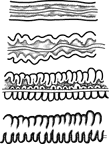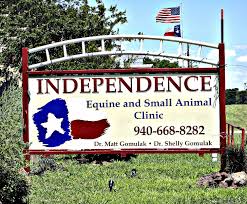With Easter less than a week away, I decided this week’s blog post should hit on a few things that we wish people outside of the veterinary field would know. It’s strange sometimes to realize that pet owners don’t know some of the things that we mistake as common knowledge. Being in the veterinary field is definitely different than any other field I have ever worked. While we come across many things in our day to day work at the clinic, there are those certain types of incidents (usually the ones that do not end well and that seem to stem from some harmless action) that have the biggest effect on us. Something that could have been easily prevented, if only the knowledge had been given to the owner prior to the incident. I think this is one of the things that has stimulated this blog. Aside from just keeping clients up to date on different happenings at the clinic, informing you all about different things that can cause harm to your pets is one of our goals. Knowledge = power. Okay, I’m getting a little teary eyed after that brief heart to heart, so let’s move on.
Easter is a wonderful time. But it also brings all kinds of potential harm to your beloved pets into your household. What things can you think of about Easter that could cause problems for your dogs or cats? I’m guessing a few of you thought of chocolate. Great job.
Chocolate
Chocolate is considered poisonous to dogs, and they should never be allowed to eat it. So, just be sure to keep an eye on any chocolate. Keep it up high and out of your pet’s reach. Make sure any children or grandchildren coming over to hunt for Easter eggs do not try to share their goodies with your dog. I have a stepson whom I have convinced from a very young age that any amount of chocolate will kill our dogs. He is now 11 years old, but just last week he dropped a piece of his candy bar and basically tackled our 100 pound dog that went to inspect the dropped food, scooping it off the ground and looking to me triumphantly. Yes, I realize a few of you out there might be thinking this is overkill, but it does get the message across. Here is a more adult explanation of why chocolate is bad for dogs:
Chocolate is poisonous to dogs; however, the hazard of chocolate to your dog depends on the type of chocolate, the amount consumed and your dog’s size. In large enough amounts, chocolate and cocoa products can kill your dog. (Thus the small dropped bite to our 100lb dog would not have caused harm, however, I’m not going to discern between what is a safe amount and what isn’t to my stepson. It is just off limits to dogs). The toxic component of chocolate is theobromine. Humans easily metabolize theobromine, but dogs process it much more slowly, allowing it to build up to toxic levels in their system.
- A large dog can consume more chocolate than a small dog before suffering ill effects.
- A small amount of chocolate will probably only give your dog an upset stomach with vomiting or diarrhea.
- With large amounts, theobromine can produce muscle tremors, seizures, an irregular heartbeat, internal bleeding or a heart attack. The onset of theobromine poisoning is usually marked by severe hyperactivity.
The usual treatment for theobromine poisoning is to induce vomiting within two hours of ingestion. If you are worried or suspect that your dog may have eaten a large quantity of chocolate and they are showing any of the signs listed above, call us immediately.
Independence Small Animal: (940) 668-8282 Extension 1
A single piece of chocolate should not be a problem. A single piece doesn’t contain a large enough theobromine dosage to harm your dog; however, if you have a small dog that has eaten a box of chocolates, you need to call us right away. Do not wait.
Different chocolate types have different theobromine levels. Cocoa, cooking chocolate and dark chocolate contain the highest levels, while milk chocolate and white chocolate have the lowest. If you’re dealing with any quantity of dark or bitter chocolate, err on the side of caution. The high level of theobromine in dark chocolate means it takes only a very small amount to poison a dog. Less than an ounce of dark chocolate may be enough to poison a 44-pound dog.
Another danger to our pets at Easter time: The stringy green fake easter grass stuff. What is it called? Who knows. If you happen to know, post it in the comment section below this post! I could look it up, but I don’t particularly like typing the word “thingy” on my google search. It sounds unprofessional. And, obviously, that’s not me. 😉
Stringy Green Fake Easter Grass
Cats love anything that moves. This is much like tinsel on the tree at Christmas time. This is a HUGE danger, that can easily be avoided. Cats love to play with it, and what do cats do when they play? They paw and claw and pull things into their mouths. What happens when they accidentally ingest this tinsel or stringy fake Easter grass? They can suffer from a Linear Foreign Body. This is an emergency situation and requires surgery. The ingested string type object can “gather up” and shred delicate tissues like the intestinal tract. It is important to not pull on any visible thread, as this can cause further damage. It basically causes the intestines to “accordion up” on itself. If too much time has passed, the tissue in the intestinal tract can lose blood flow, and eventually parts of the intestine begin to die. Once this happens, there is nothing that we can do to repair this.

The top 3 drawings show the action of the intestine as it “accordions up” on the string.
The lower illustration is the outside view of a section of intestine with a string foreign body.
We have had more than one client bring in their cat that was not eating or drinking, straining to defecate and vomiting. After getting the history from the owner, and asking if the cat plays with string, the owner suddenly realizes they saw Fluffy playing with sewing string, tinsel, or stringy green Easter grass before they started acting sick. We take the cat to surgery, and find it inside their intestine. This is something that can take the life of your cat, but can easily be avoided by being careful about the things you decorate your house with, or leave lying around. The hair ties that we all use to put our hair into a ponytail can also create the same problems. The following pictures are from an actual surgery we did at the clinic to remove a piece of ribbon from a cat.


Notice the accordion style of the intestine in the first picture. The second picture shows the removal of the ribbon. The ribbon was SO LONG. The Doctor had to cut the ribbon multiple times and make multiple incisions in the intestine to get all of it out. All in all, I would estimate the length to be approximately 12 inches. So don’t ever think that because a piece of ribbon or tinsel is long, that your cat won’t manage to swallow the entire thing. This is a very delicate surgery, and can come with a wide range of complications. Happily, this patient made a full recovery, and is doing well today. Not all cases end so well.
The final Easter Pet Danger that I want to inform you of is one of the worst we ever have to deal with. Often, it results in the death of your pet. And it is very hard for us to see something like this, that if only people were informed, their pet would not be gone.
Lily Poisoning in Cats
Most people have no idea that Lilies are deadly to cats. Stargazer lilies, Easter lily, Day lily, Asian lily and Tiger lily, are popular choices for holiday bouquets and are the favorites of many gardeners. What makes lilies poisonous is still unknown, but it is known that the toxin is soluble in water and deadly. Cats suffer from kidney failure after ingesting even tiny amounts of this plant and flower. The most toxic component is the flower itself, but all parts of this flower are toxic. As little as one or two plant pieces have caused deaths in animals. Even the pollen is toxic to cats. If you have ever been near one of these plants, you will notice the large amounts of pollen that fall from the stamen – on table tops, your nose, and clothing. The pollen is yellow to orange (depending on the lily) and gets everywhere. Cats who have pollen on them should be bathed, as they ingest pollen when they groom themselves. The first signs of Lily poisoning usually develop within 6-12 hours after ingestion. Following are the first clinical signs see with Lily Toxicity:
Vomiting, lethargy, loss of appetite, tremors and seizures. Kidney failure usually follows, within 36-72 hours of ingestion, showing these types of signs: increased thirst, increased urination at first, then lowered urine output, then no urine output, dehydration, and death.
Treatment includes hospitalization, aggressive IV fluid therapy and protection of the GI tract. But usually, our efforts end up to be futile. While we have saved some, most do not make it. Mortality rate has been reported as high as 100% with lily toxicity if untreated or treated later than 18 hours after exposure. Early, aggressive treatment by a veterinarian has a good prognosis.
One of the hardest cases I have been a part of was a client that brought her cat in because he was acting sick. We discovered through getting his history that they had just had a death in the family and their house was full of different bouquets of flowers.
My suggestion to any cat owners is to simply not have any type of Lily in your home. It is not worth the risk. This is one of the things that we wish EVERYONE knew about. It could have saved some lives of our feline friends. I have discovered a petition started that if it gets enough signatures, would require all retailers of lilies to very clearly label them as toxic to cats. Some retailers already do include a small statement, but it is not very clear and does not draw any attention to itself. If you are interested in reading or signing the petition, copy and paste this link into your browser:
I hope I didn’t ruin anyone’s love of Easter! The only thing to keep in mind is just to be aware. Knowing the dangers better prepares you to avoid them, and to keep an eye out for different potential hazards to your pet. Our pets don’t realize the dangers they face, but as their caretakers, it is our responsibility to protect them from these dangers. While they may not realize you’re doing it, your pet will always thank you for it.
-Your Veterinary Technician

